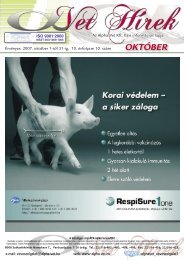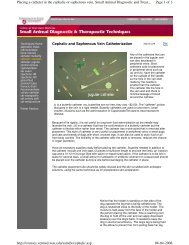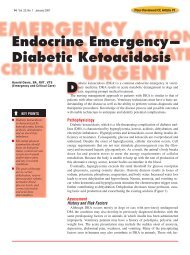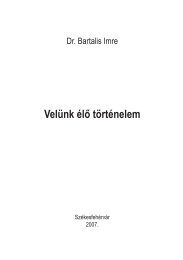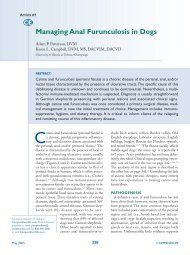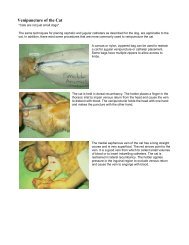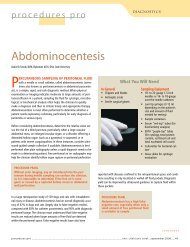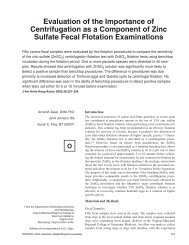evaluating blood films evaluating blood films - Hungarovet
evaluating blood films evaluating blood films - Hungarovet
evaluating blood films evaluating blood films - Hungarovet
- No tags were found...
You also want an ePaper? Increase the reach of your titles
YUMPU automatically turns print PDFs into web optimized ePapers that Google loves.
cosis, among others. 5 Splenic dysfunction (e.g.decreased clearance of circulating nucleatedRBCs) is an important cause of an inappropriaterelease of nucleated RBCs and may occur inpatients in which the spleen has been removedand in patients with splenic neoplasms,especially hemangiosarcoma.Is autoagglutination present?Agglutination is unorganized threedimensionalclumping of RBCs that must bedifferentiated from rouleau formation. It iscommon in dogs with immune-mediated hemolyticanemia. When confirmed, autoagglutinationsuggests an immune-mediatedprocess such as autoimmune-mediated hemolyticanemia or drug-induced hemolyticanemia (e.g. cephalosporins, penicillin) becauseRBC surface antibodies cause cell crosslinkingand the resulting agglutination.Rouleau formation is organized linear arraysof RBCs caused by decreased zeta potentialsfrom plasma proteins (e.g. globular proteins,fibrinogen) coating RBCs. This distinctiveformation is commonly described as stacks ofcoins. Unlike agglutination, which is a strongcross-linking between cells, rouleau is a resultof a weak binding between cells because ofdissimilar ionic charges on the RBC surface.Rouleau formation is a common finding whenfibrinogenesis is increased and must be differentiatedfrom agglutination. On routineWright’s-stained or modified-Wright’s-stained<strong>blood</strong> <strong>films</strong>, marked rouleau formation andagglutination may be difficult to differentiate.Whenever you suspect agglutination on a<strong>blood</strong> film, mix a drop of the well-mixed EDTAanticoagulated <strong>blood</strong> on a new glass slidewith two or more drops of isotonic saline solution.Add a cover slip, and view the mixtureas an unstained wet preparation. Under theseconditions, most rouleaux formations dissipatebut autoagglutination typically persists and isrecognized as clumped RBCs (Figure 5).Are poikilocytes present?Normal canine RBCs are shaped like biconcavedisks with prominent central pallor. FelineRBCs have much less apparent central pallor.Abnormally shaped RBCs are calledpoikilocytes and include artifactual changes(crenation) as well as true abnormalities (e.g.spherocytes, acanthocytes, schistocytes, leptocytes).Crenation (Figure 6 ) can be confusedwith important RBC changes such as acanthocytosis.Crenation is a shrinking artifact mostcommonly seen when less than optimalamounts of <strong>blood</strong> are collected into the EDTAtube and the peripheral <strong>blood</strong> film is notmade relatively quickly after the anticoagulationprocess. 4 Some less common causes ofcrenation include electrolyte disturbances,uremia, and rattlesnake envenomation. Auseful differentiating feature for identifyingcrenation is that crenation typically affectslarge numbers of cells in a particular area ofthe slide, whereas true poikilocytosis typicallyaffects relatively lower numbers of cellsthroughout the peripheral <strong>blood</strong> film. Crenationcan be minimized by preparing <strong>blood</strong><strong>films</strong> immediately after <strong>blood</strong> samples arecollected and properly anticoagulated.Spherocytes are spherical RBCs that havelost their normal biconcave shape, resulting inmore intense staining than normal RBCs. Theyhave no central zone of pallor, and they appearsmaller than normal RBCs (Figure 7 ).More than four to six spherocytes per 100field is considered elevated. Spherocytes arecommonly seen with many of the immunemediatedhemolytic anemias we encounter inveterinary medicine. Be careful when attemptingto identify spherocytes in feline RBCs becausefeline RBCs are much less biconcave thancanine RBCs and, therefore, have much lesscentral pallor.FIGURE 5FIGURE 6 FIGURE 7FIGURE 8 FIGURE 95. A saline wet preparation of canine <strong>blood</strong> showingautoagglutination (20).6. Crenation in a dog (modified Wright’s stain; 100).7. Spherocytes (black arrows) and a polychromatophil (redarrow) in a dog (modified Wright’s stain; 100).8. Acanthocytes (arrow) in a dog (modified Wright’s stain;100).9. Schistocytes (arrows) in a dog (modified Wright’s stain;100).10




